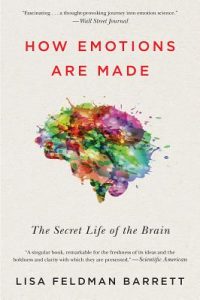 Lisa Feldman Barrett is a psychologist and neuroscientist who challenges almost everything we think we know about the concept of emotions in her book How Emotions Are Made: The Secret Life of the Brain (2017). I saw a glowing review of it on LinkedIn earlier this year and checked it out from the library to see what it was about. It did not disappoint.
Lisa Feldman Barrett is a psychologist and neuroscientist who challenges almost everything we think we know about the concept of emotions in her book How Emotions Are Made: The Secret Life of the Brain (2017). I saw a glowing review of it on LinkedIn earlier this year and checked it out from the library to see what it was about. It did not disappoint.
Feldman uses detailed evidence and examples to challenge the long-standing but lacking-in-evidence ‘classical view’ of emotions. Emotions are not hardwired into us, she says, and there are no universal emotions as we think of them. At first you want to disagree with her: but doesn’t every human feel sad and happy sometimes? As she goes deeper into the science, you realize how big a role our upbringing and our brain’s predictions about how to respond to different situations play in our experience of the world.
Some cultures don’t have a concept of anger or sadness, for instance, or have concepts that encompass a broader or narrow view of these as compared to the typical Western culture definition. They have other emotion concepts and terms, some of which may not translate outside of that group. She provides examples such as Norwegians’ concept for intense joy at falling in love (Forelsket); the Portuguese concept of a strong, spiritual longing (Saudade); and Filipinos’ urge to hug or squeeze something unbearably adorable (Gigil). People around the world have socialized themselves around concepts that make their community work. For those raised in those societies, they develop predictions based on these concepts. These concepts are normal to them. The lack of universality challenges the idea that universal emotions live somewhere in the brain.
I thought as I read her book that perhaps this explains part of why I and other foreigners have found it challenging to integrate into New Zealand – it can be impossible to ‘read’ people’s emotional expressions. But now I’m wondering how much crossover there is between our concepts of emotions in the first place. What I express as excitement, with hand gestures and smiles, often seems out of place here, for example.
Barrett’s key argument is that the classical view of emotions is incorrect and lacks foundational evidence. Emotions are not built-in from birth or automatic reactions coming from specific parts of our brain. They aren’t something that our ‘rational’ minds have to control to make us human.
Her theory offers a different explanation – one of constructed emotion. This means that as we grow up in a culture, we learn to associate certain bodily feelings with certain situations. For example, if your parent asks you “Are you sad?” every time you are crying, you will learn to associate “sad” with crying. Then we use our predictions of what is appropriate to respond to new situations. If we see someone crying, we assume they are sad. If we are crying, we assume we are sad. We eventually make these predictions so seemingly effortlessly, we believe they are hard-coded into us. Stepping outside of your cultural context can help reveal that they are constructed based on a context.

Her example of butterflies in her stomach while on a date was a great example of why the classical view doesn’t make sense. At first, she thought she was happy and excited at her date. She interpreted the butterfly feeling as going with these emotions. Later, it turned out that she was falling sick. The feeling was actually one of bodily distress. But her brain predicted that she was happy based on its prior knowledge (being out at a restaurant, etc.).
Barrett says after a century of trying, scientific research has not found a constant fingerprint for any emotion. She had me questioning why we show children faces of ‘happy’, ‘sad’, ‘angry’, and so on, when we should know from our own life experience that people don’t actually look like that universally in every situation (or even many!). If you get mad at your boss, you might yell, or you might quietly simmer. You might express your feelings in any number of ways. The caricature of an angry face probably doesn’t fit you all of the times you feel anger.
Barrett packs a lot of information into this book, more so than I can unpack here, but the examples are great at helping you understand what she means and how it applies to the real world. I’d highly recommend checking it out and being open to changing your mind about almost everything you probably think and hear about emotions! She’ll have you wondering why we have stuck with these old theories for so long, and she also gives tips on how to shift into new ways of thinking and take more control over your predictions and emotion concepts.